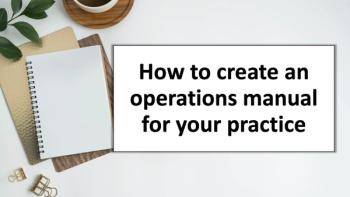
The Great Practice Makeover: RX for Solo FP
She started medical school at middle age. But life experience gave her little advantage when it came time to manage a practice.
When Pamela Middleton left a comfortable job as a college professor teaching biology and immunology to start medical school, she had some 20 years' more life experience than most of her classmates. Her father had been a doctor, her mother a nurse. She'd been denied admission to medical school before, but when she read a newspaper article about people over 40 starting their medical training, she felt she "had been called." She applied and was accepted.
She quit teaching, in part, she says, to get away from the paperwork. Now she laughs at that notion, ruefully. Middleton has been in private practice since 2001 and, seeming near the end of her rope, she turned to Physicians Practice with a plaintive, "I need help."
"Each year I have gone further into debt, working more hours and seeing more patients," Middleton wrote. "I don't know what to do now. I keep hoping that I can turn things around." Legitimate concerns, if not somewhat common - most likely shared by many of you. But there's more.
At the time of this writing, Middleton's practice was in a state of upheaval. She'd been evicted from the office she rented in a nursing home ("I had no idea things could go so sour with a change in administrators," she says), and was starting over in a nearby space being reconfigured for use as a medical office, with just a handshake for a lease. In just a little more than three weeks, she and her staff of four would pack, move, and set up a new shop, all smack in the middle of the Christmas/New Year's rush.
A new year in a brand new office seems the perfect opportunity to start with a clean slate, putting new processes in place and addressing some of the problems that have bogged the practice down.
Middleton says she's willing to give medicine another five years, but has some hard work to do in the short term to put her practice on the right course.
Her biggest hurdles? Middleton says they're organization and efficiency, keeping up with documentation, and paying off debts. There are a few other problem areas as well, namely a lack of leadership resulting in a scattered and unaccountable staff and the need to simply get a better handle on basic business functions like working and negotiating with business associates.
WHO'S IN CHARGE?
Despite the fact that Physicians Practice encourages our readers to include staff in decisions, delegate responsibilities, and avoid top-down hierarchy, we also consistently emphasize that you, the physician, are running a business and that, ultimately, your staff must look to you for direction and leadership.
Middleton appears to have little authority when it comes to dealing with her staff; she hasn't clearly established herself as the leader of the business. Here are a few examples:
- Middleton says her receptionist "comes in last and leaves first. She wouldn't fill the schedule [to capacity] for fear she'd have to stay overtime. I asked her to use the office computer to make business cards for me. She did them at home and billed me." Yes, Middleton paid the bill.
- "I spent $500 to $600 on good surgical tools and one of the people I hired thought they were disposable," Middleton says. "They were all thrown away, piece by piece."
- Of her office/billing manager, Middleton says, "She is not very efficient or well organized." Middleton also doubts this staff member's motivation to follow up on denied claims.
- "My staff has not been getting prior authorizations for imaging," Middleton complains. "I have one patient with a $3,000 MRI and I have two others with expensive tests" that Middleton is unable to bill for, according to at least one payer's contract.
- Finally, "I had [a medical assistant] who was not adequately qualified for the job. For instance, we had [Pap] samples rejected for being improperly packaged. She didn't tell me she didn't know these things." Middleton fired her after two months.
SET THE GROUND RULES
Middleton needs to establish clear expectations for her staff in terms of performance and accountability. She needs to give explicit instructions for what she wants done and how. And she needs to do a better job at screening candidates before hiring them.
Here are some suggestions:
- It may seem obvious, but checking a candidate's background is essential. Call references. Check educational institutions if you need to. We know of one practice whose "nurse" used her roommate's diploma to prove her qualifications.
- Ask candidates to perform basic duties, like rooming a patient, prepping a Pap test, or following up on a denied claim as part of the interview process. Watch them in action.
- Have the staff members who will interact with the person filling the position participate in the interview process and ask the candidate questions. It's helpful to have another perspective, and staff in the trenches may pick up red flags that you might miss.
- Put job responsibilities in writing, and tell new hires they will have to successfully complete a 90-day probationary period during which you'll assess whether it's a good fit.
These apply to all positions, from MA to nurse to receptionist.
Speaking of receptionists, Middleton appears to have fallen into the rut so many practices do: skimping on this key position.
The receptionist is on the front lines of your business. This is the first contact patients have when coming in for an appointment or phoning in. The person you hire for this position needs to have the temperament to be able to courteously deal with frustrated, upset patients, and be given the authority to solve problems. More often than not, a 20-year-old working her first job isn't professionally mature enough to handle these responsibilities, yet that's who many practices hire.
In Middleton's case, it seems as if her receptionist is lacking a basic understanding that the practice is a business and that Middleton is her boss. Turning patients away for fear of being too busy? Invoicing your employer for a task assigned to you as part of your job? Both would be grounds for a serious discussion with this employee about whether she is in the right place.
Likewise, Middleton may want to give further consideration to the position she calls her office/ billing manager. "The office is a disorganized mess," says Middleton. "We spend an inordinate amount of time looking for charts. I have a tendency to pick things up, start them, then lay them down when I'm interrupted."
She realizes she needs someone with "stunning organizational skills" to focus on the day-to-day management of the office, and wants the person currently in the position "to reduce her hours and responsibilities, doing nothing but billing, and do it at home."
Separating the office manager and billing manager roles sounds like a good plan. And Middleton's right - the office manager should be impeccably organized. However, we would caution against retaining someone as a part-time biller who, herself is not organized and apparently not very well versed in the basics of billing, collections, and coding, according to Middleton.
At the very least, whomever Middleton decides will be in charge of billing needs to follow consistent procedures for tracking and resubmitting denied claims, stay updated on payer requirements like prior authorizations, and receive ongoing coding education. The receptionist must be trained to act as a customer service ambassador, and be equipped to assist in the collections process, including insurance verification and collecting copays at time of service. And Middleton - or, ideally, her office manager - will track their performance.
ACT LIKE YOU MEAN BUSINESS
When asked to name her most pressing financial problem, Middleton doesn't hesitate: "I have over $150,000 in bank loans and credit card debt."
While she has been paying down her debt by working once a week caring for inmates at two local prisons, she really needs to take a look at the circumstances that got her into this situation in the first place. In short, Middleton appears to treat business transactions with the same sort of hands-off approach as she does dealing with her staff.
The bulk of her debt load is tied to upgrades she made to the office at the nursing home she just left. "I made the biggest mistake of my life when I agreed to pay for the leasehold improvements in my office and then did not insist on a five-year lease, or [do] anything to protect my investment," she says.
Still, at the time of our discussion, Middleton again had agreed to her new space, which contractors were redesigning to accommodate her practice, without having anything in writing. She says she and the landlord "shook hands on a five-year lease and an estimated maximum rent" of $1,400 per month, which Middleton's adviser believes is too high. The landlord is negotiating for a better rate from his bank so he can offer Middleton a lower rent, and has discussed the option of a "balloon lease."
Our calculations put the rental cost of the new space at about $5.60 per square foot - a bargain anywhere, particularly with the addition of a bathroom as part of the plan. But we would strongly urge her to have the terms of the lease in writing so she can move to a regular payment schedule as her financial situation stabilizes. Otherwise, the variability of the rent payment could turn into a crutch.
GETTING OUT OF THE RED
Middleton wants to see more patients, go paperless, improve staff efficiency, and add Saturday hours (as well as continue paying down her debt) to get to profitability.
Here's what we suggest:
Seeing more patients -
At her current pace, Middleton sees about 3,000 patients per year - about 20 percent below the median for ambulatory encounters for a family practice that sees OB patients - according to the Medical Group Management Association's (MGMA) Physicians Compensation and Production Survey, 2005 Report Based on 2004 Data.
Middleton schedules patients from 9 a.m. to 12:30 p.m., then resumes from 2 p.m. to 5 p.m., using the 90 minutes between to catch up on prescription refills and phone calls. "I am in my office until 7 p.m. most nights, and work on weekends trying to catch up on paperwork, but I'm still behind," she says. Her goal is at least 15 patients a day.
The "fourth exam room" is one way that Middleton could see more patients in a day and remain caught up on paperwork. This is how it works:
- Schedule three 15-minute slots per hour, reserving the fourth 15-minute increment to do dictation on those patients you've just seen, and answer phone calls. This should cut down dramatically on the amount of time needed to catch up at the end of the day. Your memory will be fresher, too, if you dictate closer to the time of the visit.
- Reserve an hour break at midday if you need to, but keep the telephones open. This may be the only time some patients have to call the office during their workday.
- During a 9-to-5 workday, you can see 21 patients using this model instead of the current 15. Based on a four-day workweek (Fridays are reserved for patients at the prisons), annual patient visits could be as high as 4,200. Some visits, like new patients, may require a longer, 30-minute slot, and the schedule can be adjusted to handle these.
- This system should also help cut down on staff interruptions and the resulting distracted physician. Middleton needs to make clear to her staff that she isn't to be interrupted while she's seeing patients unless there is an emergency. They can use the midday break to catch up on any issues or questions.
- Middleton can also implement same-day scheduling as she wishes, but needs to give clear guidelines to her scheduler. For example, she needs to decide how many slots to leave open each day, whether slots can be double-booked, and how to fill them. Some practices have trouble when staff start policing these slots rather than filling them as needed.
Staff efficiency -
Middleton wants to "improve staff efficiency so they don't feel overwhelmed seeing only 15 patients, and reduce the number of FTEs. They complain about how hard they work, but it must be they are not working smart," she says.
Reducing the number of employees may not be the answer. According to the MGMA's Cost Survey for Single Specialty Practices, 2005 Report Based on 2004 Data, the median number of full-time equivalent (FTE) employees is 4.59 for a family practitioner; Middleton has four.
Improving efficiencies sounds like the route to take. With only a general idea about Middleton's staff, we would recommend, again, reassessing the office/billing manager and receptionist to be sure the right people are in those spots. Middleton should be able to rely heavily on an office manager to train staff, set performance goals, and monitor how they are doing. This manager should sit down with each employee and review their usual tasks and how they are done to find specifically where processes need to change.
Saturday hours -
Middleton's thought is to offer a Saturday clinic, "but cash-only, and with no employees. I'm thinking about doing it in [nearby] Lexington, just so I can play country doctor."
A noble thought, but would it mean leasing yet another office space, or subletting from someone? Either way, it would require an additional set of expenses and would likely add more administrative time to Middleton's already out-of-kilter schedule.
She should also look closely at whether her Fridays working at the prisons pay better or worse than working in the clinic another day instead.
Finally, if she is contracted with payers, Middleton needs to bill to them. If she wants to go cash-only, it seems she should do it at all locations, not just one.
Overhead costs -
Part of getting to financial viability means stabilizing overhead costs. Middleton's monthly gross income averages $13,000; recent monthly overhead costs have varied from $11,000 to nearly $16,000. The percentage of Middleton's revenue that goes toward salaries is 44 percent, above the MGMA median of 31.5 percent for family practices, according to this year's data. Middleton's debts are dogging her; she needs to continue paying them down, getting lower interest rates if possible.
She should also review staff salary norms (available for purchase at
A monthly budget seems in order, too. That will help Middleton to keep tabs on funds coming in and going out; she'll see immediately if something unusual happens and also know what she can expect her income to be. She can also review her costs line item by line item. Can she save on supplies and services through competitive shopping, for example?
Middleton and her billing manager - or financial adviser - should be sure no money is being left on the table by way of lost charge capture, undercoding, forgotten denials, and the like. Finally, Middleton should review her fee schedule to be sure she's charging what the market will bear.
Going paperless -
Middleton admits she has a weakness for technology. The office has five PCs, plus a notebook that Middleton uses; she has bought three PDAs.
Middleton vows that in the new office, they'll start scanning and using a fax to send and receive prescriptions and refills.
She has also been doing some research into an integrated management and electronic records package. Middleton estimates that switching to a new EMR will put her another $40,000 in debt. However, there are systems designed for small practices in more affordable price ranges. At this point, however, we would suggest first getting further out from under her debt before she incurs any more. (For EMR fee comparisons, click on the Buyers Guide section, then go to The Guide: Product Comparisons.)
Joanne Tetrault is Special Projects Editor for Physicians Practice. She can be reached at
This article originally appeared in the March 2006 issue of Physicians Practice.
Newsletter
Optimize your practice with the Physicians Practice newsletter, offering management pearls, leadership tips, and business strategies tailored for practice administrators and physicians of any specialty.














